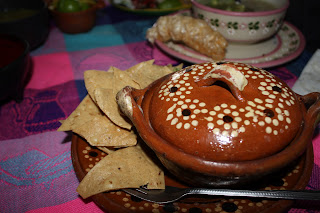 |
| How about this Cookbook Ma? Hmm...Nah! |
 |
| You are taking too long to decide...Yawn! |
 |
| I give up, you figure it out on your own. |
It is a lazy Sunday today. There is a heat wave crashing over Mexico this week, and it is hard to get motivated to do much of anything today. But alas, the peaches that I purchased on Tuesday and the jar of Blackberry Filling that has been sitting in the fridge for a few weeks are demanding to be used up. Grumble, grumble, groan...Light Bulb! My aunts gifted me with a box full of cookbooks and magazines from the 1920's to 1940's. The magazines are hilarious to this liberal minded feminist but the recipes are killer!
As you may have noticed in some of my other blog posts I leave the interpretation for a recipe wide open. I rarely follow them myself. So when I purchase a cookbook I am looking for something basic so that I can adapt and develop the recipe to be my own. These cookbooks from the 20's, 30's and 40's are exactly that (minus the Jello mold section - hee hee). They give detailed instructions, tips, tricks and how to for things like baking cakes, or how to make your pie crust extra flaky. Things we are always looking for but for some reason are not in the cookbooks of today. My favorite is the recipe for Pie Crust. It is perfect every time, never fails and renders the flakiest crust I have ever made, and I am pretty good at making pies!
For a fun blast to the past Flaky Pie Crust.
_________________________________________________________________
The America Woman's Cookbook
Edited by Ruth Berolzheimer
Copyright 1939!!!
General Directions for Making Flaky Pie Crust
To make a flaky pie crust more pains must be taken than in making the crumbly crust. Very soft fats and oils do not make as nice a flaky crust as the firmer shortenings. Bread flour may be used very satisfactorily.
In mixing the Ingredients be sure that they are cold, particularly the shortening and water. Do not use the finger-tips for mixing. The heat of the fingers softens the fat. Cut the shortening into the flour with two knives, rather quickly, and do not mix it very thoroughly; leave it in lumps or thin slices which will roll out to maker layers or flakes.
There are three methods of making flaky crust. The third one is particularly good when you want to cut down the amount of shortening used. It is harder to mix and of course the crust will not be as rich as one in which a larger amount of shortening is used, but it is not tough.
A hot oven is especially important in baking a flaky crust. Layers of cold air have been incorporated into the crust and the heat of the oven expands this air quickly, making the crust light.
It is important to prick flaky crust before baking it. Otherwise it may puff too much in one place.
Flaky Pie Crust
1 1/2 cups flour
1/2 teaspoon salt
1/2 cup shortening
3 to 4 tablespoons cold water
No. 1. Sift flour and salt. Cut in the shortening with two knives. Do not mix as
thoroughly as for crumbly pic crust, but leave shortening in small lumps or slices. Roll lightly and bake quickly in a hot to very hot oven.
No. 2. Use proportions given in No. 1. Mix as in that recipe, reserving one and one- half tablespoons of the shortening. Roll the paste out, spread with half the reserved shortening, roll up like a jelly roll and roll out with the pin. Spread with the remaining shortening, roll up and roll out again. If necessary sprinkle the board with flour to keep the paste from sticking.
No. 3. Use same proportions of flour and salt as in preceding recipes. Reduce the amount of shortening as much as one- half, if desired. Mix flour, salt and shortening as directed above. Take out one- half of the dry mixture. Add water to the remainder. Roll out in circular form. Place one-third of dry part in a row across the center of the dough and fold over from each side to make three layers. Turn half way round and roll out. Repeat twice more, until all of the dry mixture is used. Bake as usual.
Cooking Periods and Temperatures
Pie crust, shells, large pies: 400 - 450 Fahrenheit for 15 - 20 minutes
Pies, double crust with fruit filling: 450 to 425 F for 40 minutes
Single Crust (custard, pumpkin, ect): 450 to 325 F for 40 minutes
Turnovers, ect: 450F for 15 minutes
_________________________________________________________________
I know that the recipe seems to be a lot more complicated than we are used to reading but the tips are very useful and it really works better than any modern recipe that I have come across. Sometimes it is good just to slow down and do it the old fashioned way. I find that I am never disappointed when I do!








































